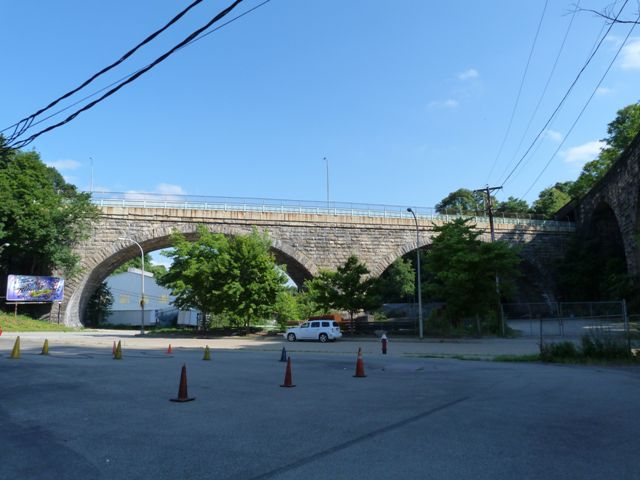We Recommend:
Bach Steel - Experts at historic truss bridge restoration.
Lincoln Avenue Bridge

Primary Photographer(s): Nathan Holth and Rick McOmber
Bridge Documented: July 17, 2011
Pittsburgh: Allegheny County, Pennsylvania: United States
1906 By Builder/Contractor: Unknown and Engineer/Design: Pittsburgh Department of Public Works
1979
130.0 Feet (39.6 Meters)
300.0 Feet (91.4 Meters)
34 Feet (10.36 Meters)
2 Main Span(s)
2730100003048

View Information About HSR Ratings
Bridge Documentation
View Archived National Bridge Inventory Report - Has Additional Details and Evaluation
This bridge is a very large example of a stone arch bridge. It has good historic integrity and also includes ornamental railings. The high level bridge is a product of early attempts by the city to begin to connect sections of the city that were separated by the many deep valleys in the city. The bridge is a rare example of a large stone arch highway bridge. Most stone arch bridges of this size in the United States are railroad bridges. Speaking of which, the roadway of this bridge runs under a high level railroad bridge at the east end of the bridge. The main spans of this railroad bridge are stone arch spans also. As such this unique setting has the appearance of two large stone arch bridges meeting together at a right angle.
Information and Findings From Pennsylvania's Historic Bridge InventoryDiscussion of Bridge The 2-span, 427'-long, stone arch bridge built in 1906 is laid up in ashlar masonry. In 1979, a concrete deck was placed, and the original decorative metal railings with a fleur-de-lis pattern reset in modern concrete parapets. Chain link fences and modern highway lighting were also added. The handsome stone arch bridge ranks as a long example of its type that is among the oldest surviving major ravine-crossing bridges in Pittsburgh. It represents the beginning efforts of the city government to improve Pittsburgh's roads by systematically spanning the many ravines that posed barriers to suburban expansion in the early 20th century. It was built to carry both highway and streetcar traffic serving residences in east Pittsburgh. The stone arch bridge is historically and technologically significant. Discussion of Surrounding Area The bridge carries a 2 lane street with 2 sidewalks over a 4 lane highway in a setting of 20th-century commercial and light industrial development. Crossing Lincoln Avenue on a steel thru girder and stone arch overpass at the bridge's east end is an active Conrail line, the former Pennsylvania RR's Brilliant branch line that connects the Main Line with industrial plants and boroughs across the Allegheny River, and provides a freight bypass around the city. The Lincoln Avenue bridge's abutment adjoins the pier of the stone arch railroad bridge. Bridge Considered Historic By Survey: Yes |
![]()
Photo Galleries and Videos: Lincoln Avenue Bridge
Bridge Photo-Documentation
Original / Full Size PhotosA collection of overview and detail photos. This gallery offers photos in the highest available resolution and file size in a touch-friendly popup viewer.
Alternatively, Browse Without Using Viewer
![]()
Bridge Photo-Documentation
Mobile Optimized PhotosA collection of overview and detail photos. This gallery features data-friendly, fast-loading photos in a touch-friendly popup viewer.
Alternatively, Browse Without Using Viewer
![]()
Maps and Links: Lincoln Avenue Bridge
Coordinates (Latitude, Longitude):
Search For Additional Bridge Listings:
Bridgehunter.com: View listed bridges within 0.5 miles (0.8 kilometers) of this bridge.
Bridgehunter.com: View listed bridges within 10 miles (16 kilometers) of this bridge.
Additional Maps:
Google Streetview (If Available)
GeoHack (Additional Links and Coordinates)
Apple Maps (Via DuckDuckGo Search)
Apple Maps (Apple devices only)
Android: Open Location In Your Map or GPS App
Flickr Gallery (Find Nearby Photos)
Wikimedia Commons (Find Nearby Photos)
Directions Via Sygic For Android
Directions Via Sygic For iOS and Android Dolphin Browser
USGS National Map (United States Only)
Historical USGS Topo Maps (United States Only)
Historic Aerials (United States Only)
CalTopo Maps (United States Only)

